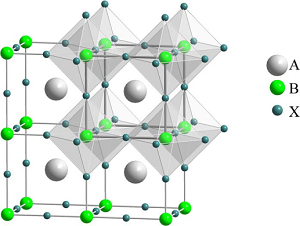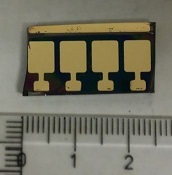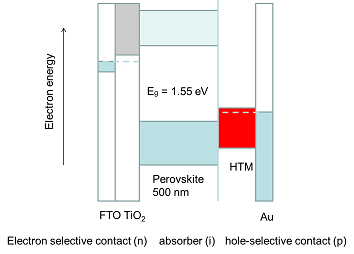Perovskite solar cells
The optoelectronic properties of perovskite materials and its versatility seem unique.
Our research in perovskite solar cells
During the last five years lead halide perovskites have emerged as a super material for optoelectronics. Perovskite solar cells and light-emitting diodes (LEDs) are approaching record efficiencies. The optoelectronic properties of perovskite materials and its versatility seem unique.
Perovskites are materials with a crystal structure similar to CaTiO3, with a general chemical formula ABX3, where A is a large cation, and B a smaller cation, which has an octahedral coordination by six X anions, see Fig. 1. In the successful lead halide perovskites, A is a large inorganic cation such as Cs+, or organic cations such as methylammonium or formamidinium, B is Pb2+, and X is a halide anion (I, Br, Cl).

Figure 1. Perovskite crystal structure.
In Uppsala, we have studied perovskite solar cells (PSC) since 2012, and are now reaching power conversion efficiencies of more than 20% in our lab. Usually, our cells have the “conventional” PSC structure, with fluorine-doped tinoxide (FTO) conducting glass and TiO2 as the substrate. The perovskite is deposited on the substrate by spincoating, followed by annealing to 100°C. Next, an organic hole transporting material (HTM) is spincoated, followed by vacuum evaporation of a metal contact (Au or Ag). TiO2 and the HTM are carrier-selective contacts: Electrons are collected at the TiO2 and holes in the HTM. A typical lab-scale device with 4 individual cells is shown in Fig. 2. The schematic structure of the PSC is shown in Fig. 3. Since the perovskite film is intrinsic, the device structure is n-i-p.

Figure 2. Perovskite solar cell.

Figure 3. Schematic structure and energy diagram of a perovskite solar cell.
Research projects
- Fundamental studies on photo-induced effects and ion conduction in lead halide perovskites.
- New synthesis methods and compositions of perovskites for improve efficiency and stability.
- Carbon nanotubes as contact material for perovskites.
- Investigation of new hole transporting materials.
- Lead-free alternatives for perovskites.
Contact
- Om du har några frågor om vår forskning så är du välkommen att kontakta professor Gerrit Boschloo.
